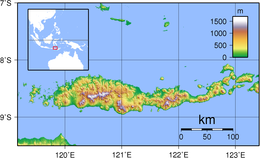 Topography of Flores | |
 Location of Flores | |
| Geography | |
|---|---|
| Location | Southeast Asia |
| Coordinates | 8°40′29″S 121°23′04″E / 8.67472°S 121.38444°E |
| Archipelago | Lesser Sunda Islands |
| Area | 14,731.67 km2 (5,687.93 sq mi)[1] |
| Area rank | 60th |
| Length | 354 km (220 mi) |
| Width | 66 km (41 mi) |
| Highest elevation | 2,370 m (7780 ft) |
| Highest point | Poco Mandasawu |
| Administration | |
Indonesia | |
| Province | East Nusa Tenggara |
| Largest settlement | Maumere (pop. 91,550) |
| Demographics | |
| Population | 1,962,405 (mid 2023) |
| Pop. density | 133.2/km2 (345/sq mi) |
Flores is one of the Lesser Sunda Islands, a group of islands in the eastern half of Indonesia. Administratively, it forms the largest island in the East Nusa Tenggara Province. Including Komodo and Rinca islands off its west coast (but excluding the Solor Archipelago to the east of Flores), the land area is 14,731.67 km2, and the population was 1,878,875 in the 2020 Census (including various offshore islands); the official estimate as of mid-2023 was 1,962,405.[2] The largest towns are Maumere and Ende. The name Flores is of Portuguese origin, meaning "Flowers".
Flores is located east of Sumbawa and the Komodo Islands, and west of the Solor Islands and the Alor Archipelago. To the southeast is Timor. To the south, across the Sumba Strait, is Sumba Island, and to the north, beyond the Flores Sea, is Sulawesi.
Among all islands containing Indonesian territory, Flores is the 10th most populous after Java, Sumatra, Borneo (Kalimantan), Sulawesi, New Guinea, Bali, Madura, Lombok, and Timor and also the 10th biggest island of Indonesia.
Until the arrival of modern humans, Flores was inhabited by Homo floresiensis, a small archaic human.
- ^ Monk, K.A.; Fretes, Y.; Reksodiharjo-Lilley, G. (1996). The Ecology of Nusa Tenggara and Maluku. Hong Kong: Periplus Editions Ltd. p. 7. ISBN 962-593-076-0.
- ^ Badan Pusat Statistik, Jakarta, 28 February 2024, Provinsi Nusa Tenggara Timur Dalam Angka 2024 (Katalog-BPS 1102001.53)